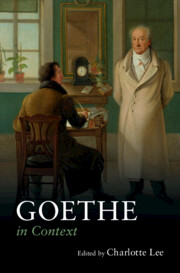Book contents
- Goethe in Context
- Goethe in Context
- Copyright page
- Contents
- Illustrations
- Notes on Contributors
- Acknowledgements
- Note on Translations and List of Abbreviations
- Chronology
- Introduction
- Part I Life and Times
- Part II Literature
- Chapter 8 Poetry
- Chapter 9 Drama
- Chapter 10 Prose
- Chapter 11 Faust
- Chapter 12 Wilhelm Meister
- Chapter 13 Classicism
- Chapter 14 Romanticism
- Part III Art
- Part IV Philosophy and Science
- Part V World Cultures Inspiration and Reception
- Part VI Goethe’s Lasting Significance
- Further Reading
- Index
Chapter 13 - Classicism
from Part II - Literature
Published online by Cambridge University Press: 16 May 2024
- Goethe in Context
- Goethe in Context
- Copyright page
- Contents
- Illustrations
- Notes on Contributors
- Acknowledgements
- Note on Translations and List of Abbreviations
- Chronology
- Introduction
- Part I Life and Times
- Part II Literature
- Chapter 8 Poetry
- Chapter 9 Drama
- Chapter 10 Prose
- Chapter 11 Faust
- Chapter 12 Wilhelm Meister
- Chapter 13 Classicism
- Chapter 14 Romanticism
- Part III Art
- Part IV Philosophy and Science
- Part V World Cultures Inspiration and Reception
- Part VI Goethe’s Lasting Significance
- Further Reading
- Index
Summary
Chapter 13 examines the development of Weimar Classicism, from the impact of Goethe’s own experiences in Italy to his collaboration with Friedrich Schiller. A crucial factor in any classicism, including that of Goethe and Schiller, is the absence of the ancients, and the chapter argues that Weimar Classicism was far from the settled, canonical project for which it is often taken. Rather, it emerged from historical crisis, above all the French Revolution, and it is characterised by internal tensions, between antiquity and modernity, desire and restraint.
- Type
- Chapter
- Information
- Goethe in Context , pp. 121 - 129Publisher: Cambridge University PressPrint publication year: 2024

